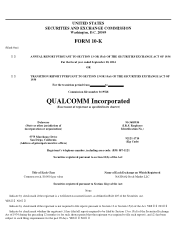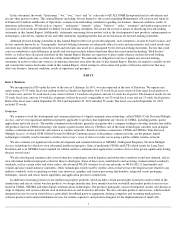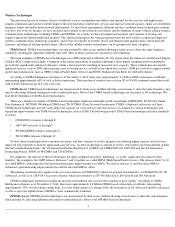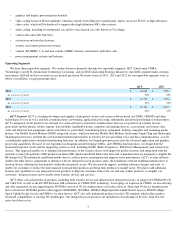Qualcomm 2014 Annual Report Download - page 11
Download and view the complete annual report
Please find page 11 of the 2014 Qualcomm annual report below. You can navigate through the pages in the report by either clicking on the pages listed below, or by using the keyword search tool below to find specific information within the annual report.
emerging regions, which may use our Qualcomm Reference Design (QRD) products, to premium-tier devices. In fiscal 2014 , QCT shipped
approximately 861 million MSM integrated circuits for wireless devices worldwide, compared to approximately 716 million and 590 million in
fiscal 2013 and 2012 , respectively.
Our modems are built to work with increasingly complex networks. They support the latest communication technologies and adapt to
network conditions and user needs in real time to enable delivery of faster, smoother data and voice connections. Our 3G/4G modem roadmap
delivers the latest network technologies across multiple product tiers and devices. This roadmap is the result of our years of research into
emerging network standards and the development of chipsets that take advantage of these new standards, while maintaining backward
compatibility with existing standards.
Each Snapdragon processor is a highly integrated, mobile optimized system on a chip incorporating our advanced technologies, including a
high performance central processing unit (CPU), digital signal processor (DSP), graphics processing unit (GPU) and modem, multimedia
subsystems, including high fidelity audio, high-definition video and advanced imaging capabilities, a hardware-based security suite and highly
accurate location positioning engines. Our CPU cores are designed to deliver high levels of compute performance at low power, allowing
manufacturers to design slim and powerful devices with longer battery life between charges. Our Qualcomm Adreno GPUs are also designed to
deliver graphics performance for visually rich 3D gaming and user interfaces. The heterogeneous compute architecture of our Snapdragon
processors is designed to ensure that the CPU, DSP and GPU work efficiently together, each being powered up and utilized only when needed,
which enhances the processing capacity, speed and efficiency of our Snapdragon processors and the battery life of devices using our processors.
Most Snapdragon processors also include our integrated Qualcomm Gobi modem technology for power efficient advanced mobile broadband.
Our wireless products also consist of integrated circuits and system software for WLAN, Bluetooth, frequency modulation (FM) and near
field communications as well as technologies that enable location data and services, including GPS, GLONASS and BeiDou. Our WLAN,
Bluetooth and FM products have been integrated with the Qualcomm Snapdragon processor devices to provide additional connectivity for
mobile phones, tablets and consumer electronics. QCT also offers stand alone WLAN, Bluetooth, Wi-Fi and Ethernet products for mobile
devices, consumer electronics, computers, home appliances and other connected devices. Our networking products include Wi-
Fi, Powerline and
Ethernet chips, network processors and software. These products enable home and business networks to support the growing number of
connected devices, digital media, data services and other smart home applications.
QCT utilizes a fabless production model, which means that we do not own or operate foundries for the production of silicon wafers from
which our integrated circuits are made. Integrated circuits are die cut from silicon wafers that have completed the package assembly and test
manufacturing processes. The semiconductor package supports the electrical contacts that connect the integrated circuit to a circuit board. Die
cut from silicon wafers are the essential components of all of our integrated circuits and a significant portion of the total integrated circuit cost.
We employ both turnkey and two-stage manufacturing models to purchase our integrated circuits. Turnkey is when our foundry suppliers are
responsible for delivering fully assembled and tested integrated circuits. Under the two-stage manufacturing model, we purchase die or wafers
from semiconductor manufacturing foundries and contract with separate third-party suppliers for manufacturing services such as wafer bump,
probe, assembly and final test.
We rely on independent third-party suppliers to perform the manufacturing and assembly, and most of the testing, of our integrated circuits
based primarily on our proprietary designs and test programs. Our suppliers also are responsible for the procurement of most of the raw materials
used in the production of our integrated circuits. The primary foundry suppliers for our various digital, analog/mixed-signal, RF and PM
integrated circuits are Global Foundries Inc., International Business Machines Corporation, Samsung Electronics Co. Ltd., Semiconductor
Manufacturing International Corporation, Taiwan Semiconductor Manufacturing Company and United Microelectronics Corporation. The
primary semiconductor assembly and test suppliers are Advanced Semiconductor Engineering, Amkor Technology, Siliconware Precision
Industries and STATSChipPAC. The majority of our foundry and semiconductor assembly and test suppliers are located in the Asia-Pacific
region.
QCT’s sales are primarily made through standard purchase orders for delivery of products. QCT generally allows customers to reschedule
delivery dates within a defined time frame and to cancel orders prior to shipment with or without payment of a penalty, depending on when the
order is canceled. The market in which QCT operates is intensely competitive. QCT competes worldwide with a number of United States and
international designers and manufacturers of semiconductors. As a result of global expansion by foreign and domestic competitors, technological
changes, device manufacturer concentrations and the potential for further industry consolidation, we anticipate the market to remain very
competitive. We believe that the principal competitive factors for our products may include performance, level of integration, quality,
compliance with industry standards, price, time-to-market, system cost, design and engineering capabilities, new product innovation and
customer support. QCT also competes in both single- and dual-mode environments against alternative communications technologies including,
but not limited to, GSM/GPRS/EDGE, TDMA and TD-SCDMA.
6
























